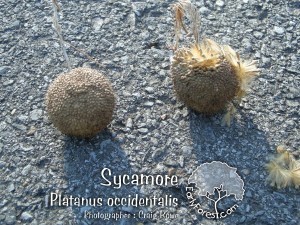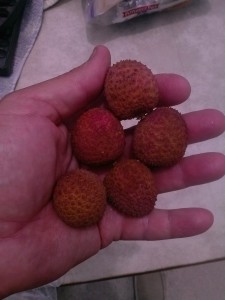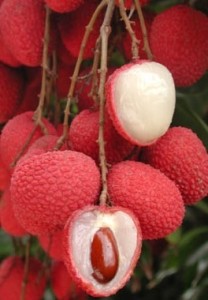Over the weekend, my buddy SB showed me another treat I never would have experienced had I stayed in the hills of West Virginia. Knowing I’m rather adventurous when it comes to food, he simply handed me a zip lock bag and said to try one. As he demonstrated the method of opening and eating them, I tried to come up with the name of the fruit that looked oddly familiar.

The bag contained several dozen small, reddish-brown, roughly textured, scaly fruits, slightly smaller than a gold ball. They looked very much like the seed pods of a sycamore tree, something I was sure wasn’t readily available here in Florida, and was also nothing worth eating.

my confusion
At least I hoped I hadn’t missed the fact that sycamore seed pods were some sort of delicacy. That would bum me out, knowing that I only used the sycamore pods for throwing at things to watch the minor explosion that would occur as the seed pod broke apart on impact.
Watching SB split the skin on the fruit, I quickly realized it was NOT a sycamore seed pod. The outer skin was tough, but split rather easily, revealing a milky white inner flesh that had the consistency of, well… an eyeball.
I’d seen these before somewhere, but hadn’t gotten to try them that I could recall…what was it??? Ah, yes, now I remember! (For the record, getting oold sucks. Do what you can to exercise your brains as well as your body, in order to keep it in top shape. Sudoku works well for me.)
“Lychee?” I correctly asked.
He then went on to tell me what he knew about them, as well as how he had managed to establish a long-standing agreement with several lychee tree owners so that he would be able to indulge every year when the fruit ripened.
 Lychee fruits are considered a drupe, much like a mango, peach, cherry, almonds, cashews, or most any other “stone fruits”. Drupes all have skin covering a fleshy part of the fruit, and a single seed in the middle.
Lychee fruits are considered a drupe, much like a mango, peach, cherry, almonds, cashews, or most any other “stone fruits”. Drupes all have skin covering a fleshy part of the fruit, and a single seed in the middle.
The flavor is very sweet, somewhat like an aromatic grape, with subtle hints of mango or peach. I completely understand why SB goes through the trouble of building relationships with lychee tree owners.
Lychees are limited to tropic and subtropic climates, with anything more than a very light frost killing them, it seems. (That is one of the benefits of my place, we never get frost. If the temperatures drop below 50, the locals freak out.) The trees can get very tall, reaching 30-80 feet in height.
Close relatives include rambutan and longan.
From researching the article,e I’ve found that lychees are easily “air layered”, or propagated by forcing a tree limb to start growing roots. It seems that some nurseries that grow lychees grow them more for the air layering and new plant propagation than for the fruit themselves. One growers simply stated
He went on to state that a single 10 foot tree tree can produce as many as 40 to 50 air layerings twice a year, yielding 80 – 100 plants at $10 each. That is a mighty fine cash crop! Plus the bonus of still getting fruit!
I need to learn more about air layering. It seems to be rather simple, perfect for a Hillbilly like me.
How to videos on air layer lychees:
So now go out and find some lychees and give them a try. I may have to look into getting one or two trees for myself….Then I can strike a deal with SB…it’s always nice to have some barter material, just in case 🙂
Peace,
db
(Sycamore photo provided by http://www.earlyforest.com/)
As always, please “like” FloridaHillbilly on Facebook, subscribe to my feed, follow me on Twitter, add it to Google+, Pinterest, Linkdn, Digg, and/or tell your friends! The more folks we can get to pull their heads out of the sand (or other dark places!), the better this country will become. Let’s not waste what our Founding Fathers did for us all those years ago.
Need something from Amazon (and who doesn’t)? I earn a small commission from purchases made when you begin your Amazon shopping experience here. You still get great Amazon service and your price is the same, no matter what.
Somebody gets the referral fee, why not allow this old Hillbilly use it to help make ends meet?
a hint on opening lychees, when they have been off the tree for a few days and turn brown and look less delicious, it is even easier to peel. just squeeze the skin like you are cracking a nut. not too hard obviously, but hard enough and the skin will split and you can pull the whole thing off in record time. more food faster? yes sir, I’ll take two please!
BTW, longan and lychee wood are preferred for making charcoal in Laos and Thailand. The trees grow quite fast and need to be trimmed to keep the fruit close to hand. so they use the abundant trimmings in charcoal production.
Thanks for the tips…and I’d hate to think of potential wasted fruit trees, if those limbs were air layered to produce more trees…but at least they are being used for a good cause – charcoal for BBQ! 😛
Thanks for the input…its information like this that makes me happy to go through the effort to post. Now I know even more than what I could find while researching.
Thanks CHopper!
I looooove lychees! Next season I’m going to try growing some from seeds.
Let me know how that goes….I’m interested in seeing how long it takes to produce fruit from seeds.